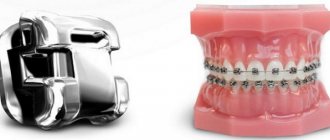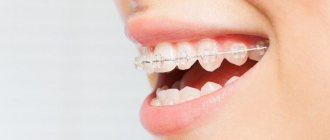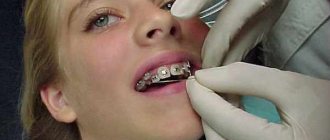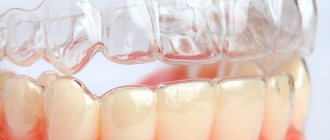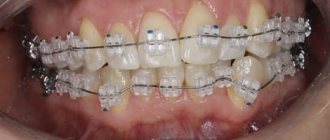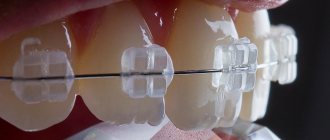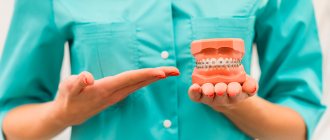Orthodontist, Ph.D. Tatyana Vladimirovna Gevorkyan
Braces are completely harmful to teeth, as they cause caries and thin out tooth enamel, and also have a detrimental effect on the gums.
It is a myth.
No matter how strange it may sound, but in our time, when any information can be easily and naturally gleaned from the press, television and, of course, the Internet, orthodontics is still shrouded in a mass of myths, sometimes close to the truth, sometimes erroneous, and sometimes completely absurd. And all this would be “nothing” if only it did not harm the treatment process and did not deprive people of even the hope of getting a beautiful smile through ortho-correction.
We continue the most interesting and useful topic for you - “the most common myths about orthodontics.” So, myth number 3:
Installation of braces in adulthood
Orthodontic treatment with braces in Russia goes back about thirty years. And in the USA, for example, bite correction with braces has been practiced for more than a hundred years. Russian orthodontists today often work with adults who simply did not have the opportunity to undergo this level of treatment in childhood. As a rule, such patients themselves turn to the dentist, less often - through the referral of related specialists. As a rule, people come to orthodontists for a beautiful smile, and not because of any pain. Most of those applying are women. Men are more relaxed about imperfect smiles, although doctors have recently noted an increase in the number of male patients.
Getting used to braces
The patient gets used to the braces system in the mouth within a couple of weeks. When the physiological movement of teeth begins, people experience discomfort due to aseptic inflammation of the bone. Patients with self-ligating braces stop feeling pain after a couple of days; when installing ligature structures, the discomfort goes away on the sixth day. The level of discomfort is influenced by the pain threshold, which is individual for each person.
Sometimes, at the initial stage of treatment, nitinol round wires cause discomfort. A glass of cold water relieves discomfort. Due to the physical properties of the thermal activity of the metal, the tension decreases and the discomfort goes away.
The metal of nitinol arcs is in one of two phases. When the temperature changes, the crystal lattice of the alloy changes from the martensite state to the austenite state and back. The doctor inserts a thermoactive arc into the grooves of the braces; under the influence of the temperature of the oral cavity, the arc straightens and gently pulls the teeth along with it. If the discomfort persists for a long time, the doctor prescribes painkillers to the patient.
Does it make sense to get braces as an adult?
Correcting a pathological bite or incorrect position of teeth is, of course, not a matter of life and death. Rather, it is a matter of regaining self-confidence. The “curvature” of teeth has little effect on communication; after all, we perceive a person holistically, and not solely the state of his bite. But, you see, an open wide smile of any person will make him more attractive in our eyes. And only people who are not embarrassed to show off their teeth smile like that. Plus, when we talk about bite, it's not just about beauty, it's also about functionality. Nature intended that when chewing, the load on the teeth should be distributed evenly - this is only possible with straight teeth and a healthy bite. If this is not the case, then over time a person develops problems with the dental system: pain appears, clicks when opening and closing the mouth, etc. Therefore, orthodontic treatment for adult patients is not only possible, but also necessary.
Operating principle
Structurally, braces are a rather complex technical system. Each tooth has its own bracket, and then they are all connected using an arch made of a special alloy. A distinctive feature of such an arch is that it is able to move and return to a given shape, which corresponds to the correct bite. Moving in a certain direction, the arch sets the teeth in motion, which move to where it is needed. The pressure force and arch rigidity required are not the same, so during the treatment process the orthodontist adjusts these parameters to achieve the desired effect. You can learn more about who an orthodontist is here. How often the rigidity of the arch should be changed is decided only by the doctor, who must take into account such parameters as the complexity of the pathology and the type of orthodontic structure.
At what age does it make sense for adults to get braces?
In any case, there are no age restrictions. There are surmountable obstacles: the general condition of the teeth, periodontal and gum diseases, and possible common concomitant diseases. Absolute contraindications for installing braces for adults coincide with many other types of treatment: lack of teeth, tuberculosis, diabetes, a number of immune diseases, epilepsy, bone pathologies, blood diseases. If a person gets braces when he is over thirty, the treatment will be quite long, since tissue regeneration occurs more slowly due to age. Plus, skeletal growth has already been completed, and the position of the bones can be “corrected” only when they are still growing - in childhood and adolescence. However, dentists achieve excellent results with mature patients.
Specifics of treatment with braces in adults
Adult patients should keep in mind that it is often necessary to remove teeth to achieve a high-quality result of orthodontic treatment. This does not mean that every patient needs it; removal is carried out only in cases where there is not enough space to restore the normal position of the teeth. Foreign orthodontists change the jaw size of adults using surgery. In Russia, orthognathic surgery is not yet particularly widespread due to the fact that our patients are extremely reluctant to agree to undergo operations. Let us repeat that this is just information about how it might be. In most cases, orthodontic treatment for adults is limited to simply installing braces.
Fixing the system
Before installing braces, the orthodontist conducts a diagnosis and agrees on a treatment plan. The doctor refers the patient to professional oral hygiene. The procedure is necessary to keep the enamel under the braces intact.
The doctor treats the area of fixation with orthophosphoric acid and applies a primer. The primer contains fluorine compounds that penetrate the enamel. Fluorine molecules are embedded in the crystal lattice of hydroxyapatite enamel and reduce permeability to carious bacteria. Before fixation, the doctor applies light-curing materials, for example Blugloo, Grengloo, Enlight, to the base of the bracket.
Fixation methods
The doctor fixes the braces directly or indirectly. Regardless of the method, installation is painless for the patient.
In the case of the direct method, the orthodontist positions each bracket according to anatomical landmarks, the projection of the root in the bone tissue and the inclination of the tooth manually. Next, the material is illuminated with a polymerization lamp. The patient spends 30 to 50 minutes in the chair.
With the indirect fixation method, the manipulation takes 10–15 minutes and does not cause discomfort to the patient. The procedure consists of several stages:
- The orthodontist manually positions each bracket on plaster models of the jaws;
- transfers braces to a silicone tray;
- applies adhesive to braces;
- During the visit, he moves the elements of the system from the tray onto the prepared enamel and illuminates it with a polymerization lamp.
Fixation of the structure is a key stage of treatment, regardless of the method used. The orthodontist adjusts the width of the teeth and creates an aesthetic smile arch through the correct positioning of each element of the system. Braces work out torque, rotation and angulation. The doctor installs the arc into the slots and releases the patient until the next activation.
Which braces are most often installed in adults?
It is most rational to choose metal braces: they are the most durable, and since the treatment will be long, this is one of the most important indicators. When it comes to minor corrections, aesthetic systems made of ceramics or artificial sapphires can be installed. But, let’s say, ceramic braces are quite fragile compared to metal ones. If the ceramic lock is chipped, you will need to remove it and install a new one. And this is a waste of time: when the lock is re-glued, the treatment can be considered to begin anew. When choosing a brace system, it is best to listen to the orthodontist’s recommendations - the doctor selects or combines types of structures so that the treatment is as comfortable as possible.
Alternative to treatment with braces
An alternative to braces is aligners. Transparent hard aligners are used to move teeth in cases where the patient has increased aesthetic requirements. The aligners are made in the laboratory on a 3D printer based on an impression of the jaws. Patients change aligners in the order specified by the doctor. The disadvantage of aligners is the high cost of treatment, but the advantage is the aesthetic component: the aligners are invisible to others. Treatment with aligners takes longer and is suitable for clinical cases of mild to moderate complexity.
The doctor attaches attachments made of composite material to the teeth, on which the mouth guard presses. The teeth move slowly; halfway through the treatment, the orthodontist takes an impression of the jaw and sends it to the laboratory to make new aligners.
Is it possible to correct an adult's bite without braces?
You can - with the help of aligners. These are orthodontic transparent aligners made of solid polymer. Despite their rather simple appearance, aligners cope well with both minor changes in the position of the teeth and quite serious pathologies of the dentofacial apparatus. When treating with orthodontic aligners, patient motivation is extremely important. Aligners are more often chosen by men - they think that this type of treatment is less problematic. But they often lack patience and remove the aligners as soon as they feel discomfort. And this is unacceptable if the patient expects a positive effect of treatment. Aligners need to be worn 22 hours a day - keep this in mind before choosing this treatment option. If you comply with this requirement, then treatment with braces will not be necessary - mouthguards are no less effective at restoring the anatomically correct position of the teeth and correcting the bite.
How to brush teeth with braces
Regardless of the type of braces and the number of visits to the clinic, a person needs to carefully monitor their oral hygiene. Orthodontic patients follow a diet. Doctors recommend eliminating sticky foods: toffee, halva, nougat, chips, chewing gum, consuming with caution and cutting hard vegetables and fruits into pieces. It is not recommended to drink coffee, red wine and other drinks with dyes. Orthodontists advise avoiding cold or very hot foods: sudden temperature changes damage metal and sensitive ceramics in the oral cavity.
With braces, brushing your teeth becomes more difficult. Using circular movements of an orthodontic toothbrush, the patient removes food debris and plaque from the vestibular surface of the teeth and the space around the bracket. The internal and chewing surfaces are cleaned with a manual toothbrush. The space around the braces and in hard-to-reach places is cleaned with a monotuft brush and dental brushes. Doctors advise using superfloss and irrigator.
It is necessary to brush your teeth three times a day after meals and perform professional oral hygiene in the clinic every 2 to 4 months. By following the doctor's recommendations and maintaining oral hygiene, the patient speeds up treatment.
Braces do not damage the enamel; caries occurs as a result of poor hygiene. The intensity of plaque depends on the type and size of the structure, but the main factor is the patient’s willingness to brush their teeth thoroughly and regularly. Caring for the oral cavity with small self-ligating appliances is easier than with ligature structures. Food remains under elastic and metal ligatures, which leads to the formation of caries.
What are the best “adult” braces according to reviews?
Most adult patients respond positively to lingual braces. They are fixed on the back surface of the teeth and are absolutely invisible to others. This type of braces has the lowest profile: the clasps of the systems are lower than all others, and therefore do not interfere with diction, do not irritate the mucous membranes, and do not scratch the tongue. Adults also often choose non-ligature ceramic braces - they are practically invisible, quite durable and cheaper than sapphire structures. When choosing a vestibular system that is fixed on the front surface of the teeth, it is worth considering that no matter what invisible material its clasps are made of, the orthodontic arch will always be noticeable. Therefore, you can safely choose classic metal braces. Ultimately, preference for a particular design comes down to its price.
Retainers: why are they worn after braces are removed?
A retainer is a device that looks like an arch. It is placed on the back surface of the teeth when braces are removed. This way the new position of the teeth is secured. The ligamentous apparatus of the teeth has muscle memory, so no matter how we move the teeth, they will tend to return to their “original” position. Wearing a retainer is an essential part of orthodontic treatment. This is especially true for people over twenty-five years of age. A retainer is installed for at least two periods of wearing braces: for example, the patient wore them for one year, then the retainer will need to be worn for two years. Foreign orthodontists generally argue that you need to wear retainers constantly - this is the only way to guarantee that your teeth will remain straight. In general, after some time the retainer can be replaced with a night guard or plate. But some kind of structure supporting the new position of the teeth will definitely be needed - this is a classic. Unfortunately, patients often neglect this stage of treatment, experience relapses and begin to talk about the ineffectiveness and uselessness of orthodontic treatment in adulthood.
What facial changes will occur after the bite is corrected?
After full or partial compensation of jaw anomalies, the face becomes proportional and symmetrical. However, some patients find these changes too pronounced. Transformations concern not only the oval of the face. They also affect the cheeks, cheekbones, nose, lips and chin. Let's consider all cases in more detail.
How do braces change a person's face?
- 1. Cheeks
. Before installing braces, it may be necessary to remove “eights” (“wisdom teeth”). In this regard, even before fixing the structure, it will be noticeable that instead of plump cheeks, sunken cheeks “appeared”. Also, when wearing braces, difficulties arise with chewing solid food. Dietary restrictions also affect cheek swelling. Typically, the slight hollowing effect persists even after the braces are removed. Almost all patients are satisfied with this effect. - 2. Cheekbones
. The muscle load is redistributed, facial expressions change, the cheeks become somewhat sunken, and therefore the cheekbone line becomes more pronounced. After correcting the abnormality, the muscles responsible for closing the lips face less stress. - 3. Nose
. When a patient wears external braces on the upper jaw, his nose becomes somewhat upturned. This effect gives the profile a special charm. However, it can persist even after the structure is removed. - 4. Lips
. While wearing braces, slight swelling of the lips may appear. But the effect disappears after removing the braces. - 5. Oval face
. When the upper jaw no longer protrudes, the face becomes longer and more oval. If before orthodontic treatment the lower jaw fell forward, then after removing the braces the face will appear smaller and rounder. This straightens the contour. - 6. Chin
. The shape of the chin may also change. If it has been smoothed, it may move forward, causing the profile to become smoother. If before installing the braces it seemed that the lower jaw was too massive, then after correcting this defect the chin will move back.
In order to better examine the described changes, patients take before and after photos. Thanks to a comparative analysis, it is easier to notice all the facial transformations and evaluate how much you like them.
How long should adults wear braces?
It is impossible to answer this question unambiguously: maybe one year, or maybe several years. Bite correction in adult patients is a long, labor-intensive process that requires patience and discipline. Therefore, orthodontists rarely persuade adults to straighten their teeth. If a person himself does not want this, then nothing will force him to conscientiously fulfill all the doctor’s demands. When treating adults with orthodontics, it is important that the dentist find a compromise between what he wants to achieve and what the patient wants to achieve. Orthodontists, of course, always strive to restore the perfectly aligned position of teeth, no matter how long it takes - at least three years, at least five years. The patient may get tired of the treatment and abandon it. The dentist’s main task is to honestly tell you how long the treatment will take and how it will proceed. And then hear whether the patient is ready to go this route.
Price of braces for adults in Moscow
To avoid misleading you, we will not indicate specific amounts. Because orthodontic treatment for adults is time-consuming and often requires additional or preparatory procedures, its overall cost cannot be low. But the opportunity to smile broadly without embarrassment is priceless at any age! Therefore, it makes sense to schedule a consultation with an orthodontist, no matter how old you are. After examination and research, the doctor will tell you the exact cost of treatment in your case.


